
Street brawling games aren’t my favorite kind of games to play, but I do like playing them with friends. By myself, I’m just awful at these games. Streets of Rage 4 caught my attention during Mike Uyama’s Summer Games Done Quick 2020 run. I found it so amazing to watch someone who was VERY good at the game. Each move was executed with perfection and it was magical to watch. The game is extremely gorgeous. All of the animations are very fluid and really have an impact making each hit feel powerful. In the end, I think I enjoy watching other people play these types of games more than playing them. It is because I get distracted and lose my character in all the chaos on the screen.

In Streets of Rage 4, they allow you to pick what the food drops look like in the game. You can go for the classic whole chicken but if you are feeling fancy you can swap it out for croissants! Croissants are one of the more complicated breads to make. I believe a lot of that difficulty comes from making sure the butter doesn’t melt and you are able to get many layers of butter in between the dough. It is extremely important that you keep the butter cold as you are working with it during this whole process. This is a multi-day process, so make sure to plan accordingly. This recipe is my own adaptation but I do want to give a shout out to two videos that really helped me to understand this whole process. First, Josh Weissman’s video really helped me understand the method of rolling and preparing the dough. Secondly, Alex’s Croissant series helped explain a bit of the science and reasoning behind the method. Without either of these I probably would have been fumbling through but now I really find this whole process relaxing. When I make a batch of croissants, I do two batches of this recipe. While one set is resting the other one is getting worked on and then I end up with 12 large croissants. This recipe is a long one and will take a lot of work but it is really worth it!
Jump to Printable RecipeButter Block
140 g unsalted butter
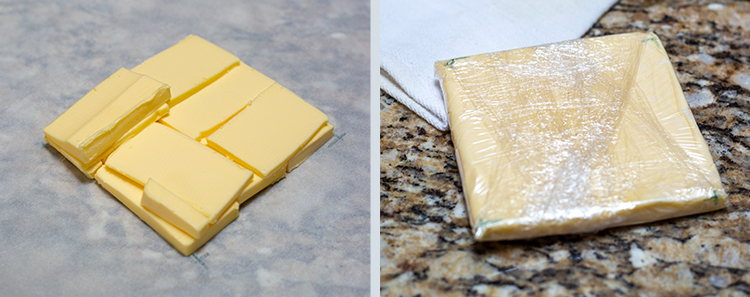
Take the butter and cut into equally thick pieces. Arrange the butter into a 4-inch square on top of plastic wrap. Wrap and make sure it is shaped like a square. Take a rolling pin and smooth the butter into the square shape of the plastic, merging the butter together into one solid piece. Place in the refrigerator for at least 30 minutes, to keep cold.
Dough
60 g water
70 g whole milk
6 g yeast
250 g bread flour
30 g sugar
6 g salt
20 g unsalted butter, melted
Egg Wash
1 egg

Heat the water and milk between 100°F to 110°F. Add the yeast and allow it to bloom, about three minutes. Combine the bread flour, sugar, and salt in a large bowl. Add the yeast mixture and melted butter.
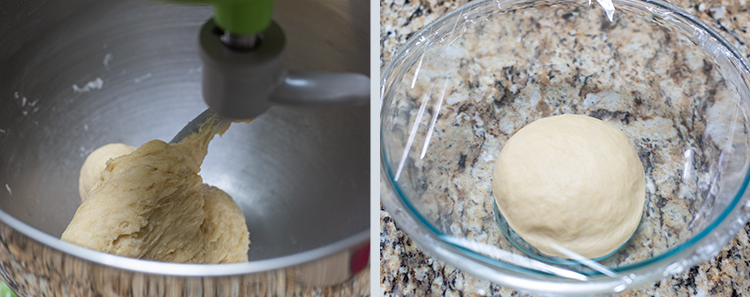
Mix together until it comes together. Transfer to a floured surface and knead until smooth. Place in a bowl, cover, and let rest for ten minutes.
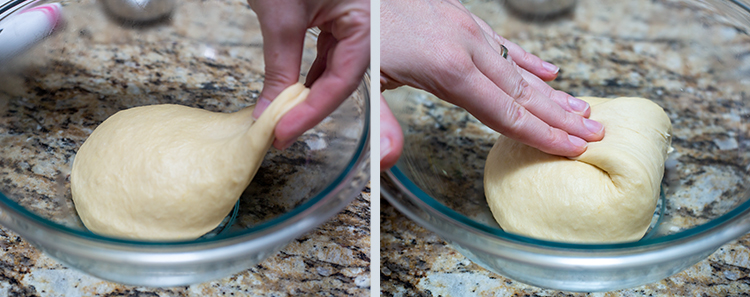
Take the rested dough and lightly pull on the edge of the dough to the center and pat down.
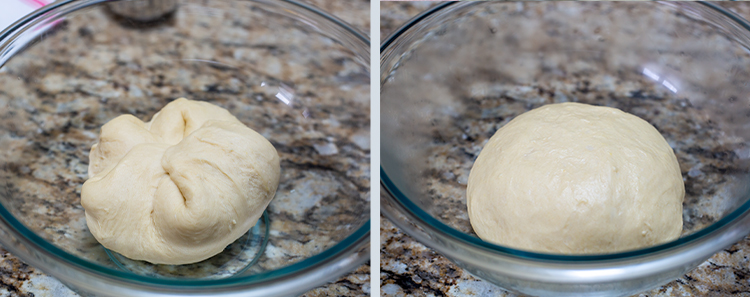
Repeat this around the entire dough. Flip, cover again, and rest for another ten minutes. Once again pull the edges to the center and pat down again. Flip, cover again, and rest for another twenty five minutes.
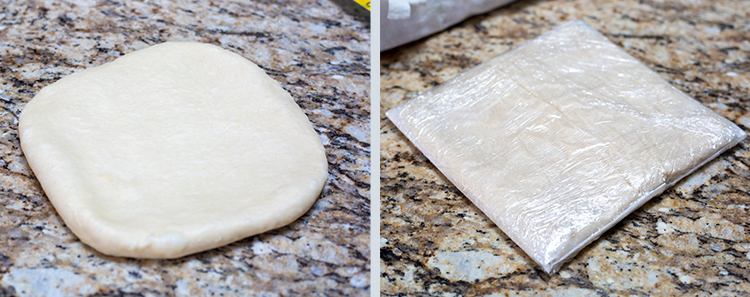
Transfer the dough to a sheet of parchment paper and roll out to a rough 7-inch by 7-inch square. Fold the parchment paper over the dough into a 7-inch square. Use a rolling pin to make sure the dough fills the square and is even. Wrap with plastic wrap and place in the refrigerator for 18 to 24 hours.
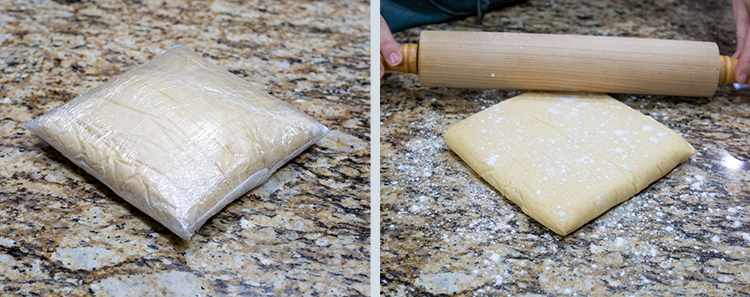
The next day, flour a countertop. Remove the dough from the plastic and parchment wrapping and place on the flour. Lightly flour the top of the dough. With a rolling pin, roll each of the corners.
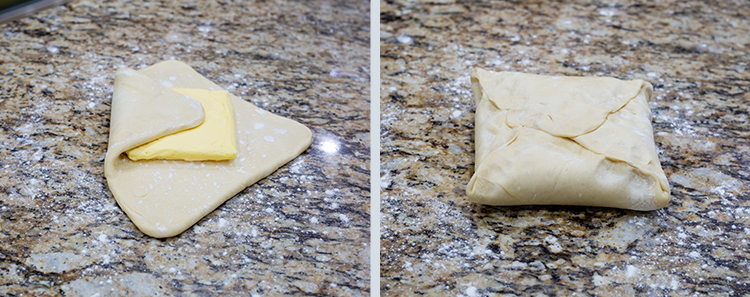
Take the butter block out of its wrappings and place it in the center, diagonally of the dough. Fold each of the corners over the butter like your sealing an envelope. Lightly tap with the rolling pin and let rest for three minutes.
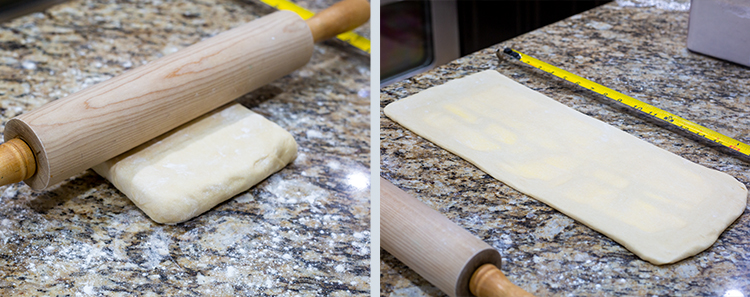
Flip the dough over so the smooth side is facing upwards. Lightly press down the dough with the rolling pin. Roll out the dough to an 18-inch long rectangle.
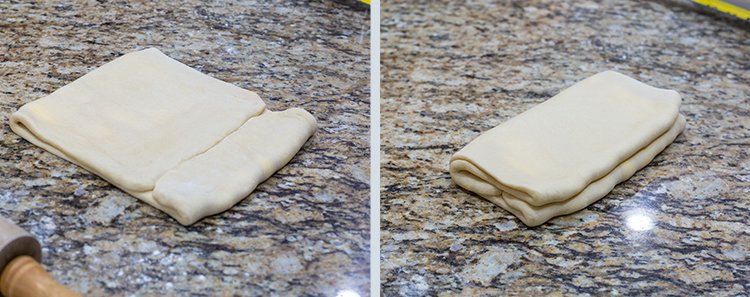
Take the bottom of the rectangle and fold it ¾ths of the way up. Grab the top of the dough and fold it, to have both edges touching one another. Take the new bottom of the rectangle and fold it to the top. Turn it 90° and lightly tap down with the rolling pin. Wrap in plastic wrap and let rest in the refrigerator for one hour.
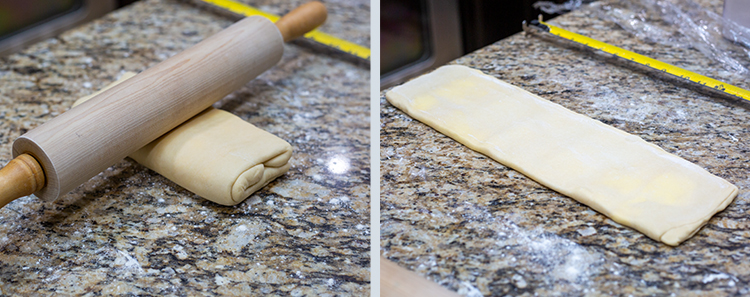
Remove the dough from the refrigerator, take it out of the plastic wrap (save this as you’ll use it again), and place on a floured countertop. Make sure the dough is positioned in the long direction, as pictured above. Take a rolling pin and tap down on the dough once more. Roll out the dough to an 18-inch long rectangle.
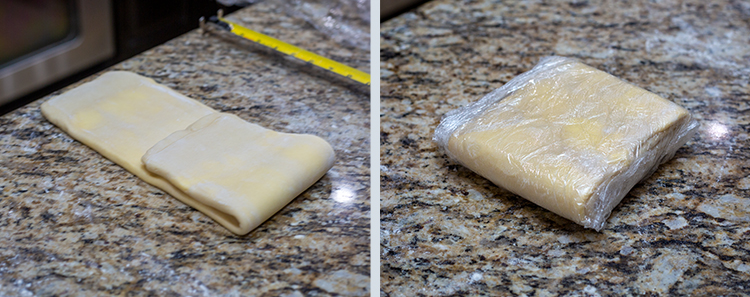
Take the top of the rectangle and roll it ⅔rds of the way down. Fold the bottom part over. You should end up with a square shape at this point. Once again, wrap in plastic wrap and place in the refrigerator to rest for 30 minutes.
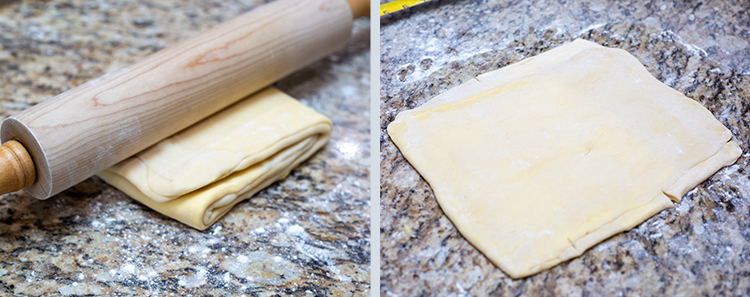
Remove the dough from the refrigerator, take it out of the plastic wrap, and place on a floured countertop. This time, roll the dough to a large rectangle that is ¼-inch thick (should be about 10-inches wide). Cut marks at the bottom 3 ½-inches apart from one another. Make similar marks at the top in the middle of each of the marks you made at the bottom. This will be your guide for cutting out the triangles.
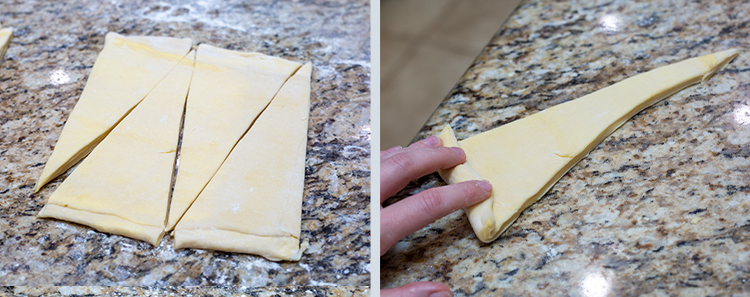
Using either a large chef’s knife or a pizza cutter, connect the bottom mark to the top diagonally to cut the dough into triangles. Take one of the triangles and tightly roll the wide part to the thin part, making sure the tip is in the center.
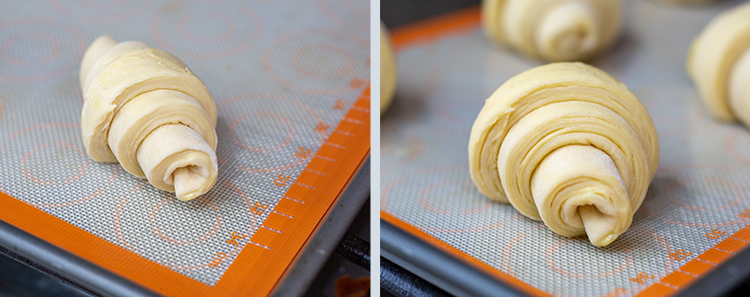
On a baking sheet with parchment paper, place the rolled triangle tip-side on the bottom, as pictured above. Repeat this with the remaining triangles, making sure to give each of the croissants about 3-inches of space between each other. Cover with a kitchen towel and let rest in a warm spot for one hour, or until the croissants have doubled in size.
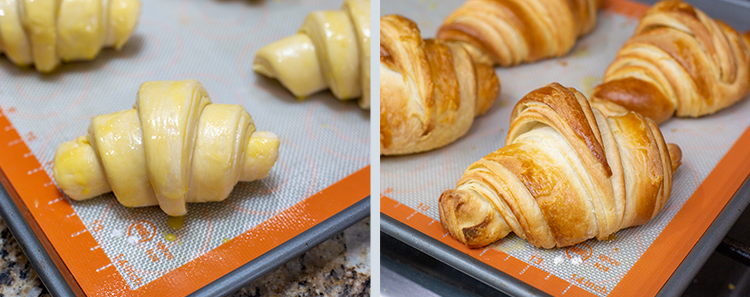
Preheat an oven to 390°F. Whisk an egg for an egg wash. Carefully brush each of the proofed croissants. Make sure to not apply any pressure that could cause the croissants to deflate. Place the baking sheet in the oven and reduce the heat to 350°F. Bake for 15 to 20 minutes or until golden brown.

Croissants
Ingredients
Butter Block
- 140 g unsalted butter
Dough
- 60 g water
- 70 g whole milk
- 6 g yeast
- 250 g bread flour
- 30 g sugar
- 6 g salt
- 20 g unsalted butter melted
Egg Wash
- 1 egg
Instructions
- Take the butter and cut into equally thick pieces. Arrange the butter into a 4-inch square on top of plastic wrap. Wrap and make sure it is shaped like a square. Take a rolling pin and smooth the butter into the square shape of the plastic, merging the butter together into one solid piece. Place in the refrigerator for at least 30 minutes, to keep cold.
- Heat the water and milk between 100°F- 110°F. Add the yeast and allow it to bloom, about three minutes. Combine the bread flour, sugar, and salt in a large bowl. Add the yeast mixture and melted butter.
- Mix together until it comes together. Transfer to a floured surface and knead until smooth. Place in a bowl, cover, and let rest for ten minutes.
- Take the rested dough and lightly pull on the edge of the dough to the center and pat down.
- Repeat this around the entire dough. Flip, cover again, and rest for another ten minutes. Once again pull the edges to the center and pat down again. Flip, cover again, and rest for another twenty five minutes.
- Transfer the dough to a sheet of parchment paper and roll out to a rough 7-inch by 7-inch square. Fold the parchment paper over the dough into a 7-inch square. Use a rolling pin to make sure the dough fills the square and is even. Wrap with plastic wrap and place in the refrigerator for 18 to 24 hours.
- The next day, flour a countertop. Remove the dough from the plastic and parchment wrapping and place on the flour. Lightly flour the top of the dough. With a rolling pin, roll each of the corners.
- Take the butter block out of its wrappings and place it in the center, diagonally of the dough. Fold each of the corners over the butter like your sealing an envelope. Lightly tap with the rolling pin and let rest for three minutes.
- Flip the dough over so the smooth side is facing upwards. Lightly press down the dough with the rolling pin. Roll out the dough to an 18-inch long rectangle.
- Take the bottom of the rectangle and fold it ¾ths of the way up. Take the top of the dough and fold it, to have both edges touching one another. Take the new bottom of the rectangle and fold it to the top. Turn it 90° and lightly tap down with the rolling pin. Wrap in plastic wrap and let rest in the refrigerator for one hour.
- Remove the dough from the refrigerator, take it out of the plastic wrap (save this as you’ll use it again), and place on a floured countertop. Make sure the dough is positioned in the long direction, as pictured above. Take a rolling pin and tap down on the dough once more. Roll out the dough to an 18-inch long rectangle.
- Take the top of the rectangle and roll it ⅔rds of the way down. Fold the bottom part over. You should end up with a square shape at this point. Once again, wrap in plastic wrap and place in the refrigerator to rest for 30 minutes.
- Remove the dough from the refrigerator, take it out of the plastic wrap, and place on a floured countertop. This time, roll the dough to a large rectangle that is ¼-inch thick (should be about 10-inches wide). Cut marks at the bottom 3 ½-inches apart from one another. Make similar marks at the top in the middle of each of the marks you made at the bottom. This will be your guide for cutting out the triangles.
- Using either a large chef’s knife or a pizza cutter, connect the bottom mark to the top diagonally to cut the dough into triangles. Take one of the triangles and tightly roll the wide part to the thin part, making sure the tip is in the center.
- On a baking sheet with parchment paper, place the rolled triangle tip-side on the bottom, as pictured above. Repeat this with the remaining triangles, making sure to give each of the croissants about 3-inches of space between each other. Cover with a kitchen towel and let rest in a warm spot for one hour, or until the croissants have doubled in size.
- Preheat an oven to 390°F. Whisk an egg for an egg wash. Carefully brush each of the proofed croissants. Make sure to not apply any pressure that could cause the croissants to deflate. Place the baking sheet in the oven and reduce the heat to 350°F. Bake for 15 to 20 minutes or until golden brown.
These look so good! All of the food that you put on here looks amazing! Sadly I’ve only been able to make one or two recipes on your blog but they were great!